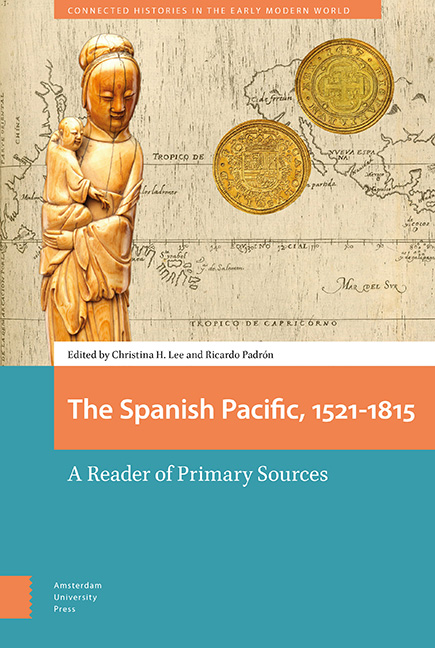Book contents
- Frontmatter
- Contents
- Abbreviations
- Acknowledgements
- Introduction
- 1 An Early Transpacific Account of the Spice Islands by Andrés de Urdaneta (1536)
- 2 Domingo de Salazar’s Letter to the King of Spain in Defense of the Indians and the Chinese of the Philippine Islands (1582)
- 3 Juan Cobo’s Map of the Pacific World (1593)
- 4 A Royal Decree of Philip III Regulating Trade between the Philippines and New Spain (1604)
- 5 Manila’s Sangleys and a Chinese Wedding (1625)
- 6 Don Luis Castilla Offers to Sell Land in Manila (1629)
- 7 Idolatry and Apostasy in the 1633 Jesuit Annual Letter
- 8 The Will of an Indian Oriental and her Chinos in Peru (1644
- 9 Francisco de Combés’s History of Mindanao and Jolo (1667)
- 10 Between Fiction and History in the Spanish Pacific The Misfortunes of Alonso Ramírez (1690)
- 11 A Moluccan Crypto-Muslim before the Transpacific Inquisition (1623–1645)
- 12 Constitutions and Rules of the Beatas Indias (1726)
- 13 The Poetics of Praise and the Demands of Confession in the Early Spanish Philippines: Notes and Documents
- 14 The Pacific Theater of the Seven Years’ War in a Latin Poem by an Indigenous Priest, Bartolomé Saguinsín (1766)
- 15 A Prohibition on Digging Up the Bones of the Dead (1813)
- Index
2 - Domingo de Salazar’s Letter to the King of Spain in Defense of the Indians and the Chinese of the Philippine Islands (1582)
Published online by Cambridge University Press: 20 November 2020
- Frontmatter
- Contents
- Abbreviations
- Acknowledgements
- Introduction
- 1 An Early Transpacific Account of the Spice Islands by Andrés de Urdaneta (1536)
- 2 Domingo de Salazar’s Letter to the King of Spain in Defense of the Indians and the Chinese of the Philippine Islands (1582)
- 3 Juan Cobo’s Map of the Pacific World (1593)
- 4 A Royal Decree of Philip III Regulating Trade between the Philippines and New Spain (1604)
- 5 Manila’s Sangleys and a Chinese Wedding (1625)
- 6 Don Luis Castilla Offers to Sell Land in Manila (1629)
- 7 Idolatry and Apostasy in the 1633 Jesuit Annual Letter
- 8 The Will of an Indian Oriental and her Chinos in Peru (1644
- 9 Francisco de Combés’s History of Mindanao and Jolo (1667)
- 10 Between Fiction and History in the Spanish Pacific The Misfortunes of Alonso Ramírez (1690)
- 11 A Moluccan Crypto-Muslim before the Transpacific Inquisition (1623–1645)
- 12 Constitutions and Rules of the Beatas Indias (1726)
- 13 The Poetics of Praise and the Demands of Confession in the Early Spanish Philippines: Notes and Documents
- 14 The Pacific Theater of the Seven Years’ War in a Latin Poem by an Indigenous Priest, Bartolomé Saguinsín (1766)
- 15 A Prohibition on Digging Up the Bones of the Dead (1813)
- Index
Summary
Abstract
Domingo de Salazar (c.1512–1594) was the first bishop of the Philippines, a member of the Dominican order, and a follower of noted critics of the Spanish imperial enterprise like the jurist Francisco de Vitoria and the historian/activist Bartolomé de las Casas. In this letter to King Philip II, Salazar denounces the abuses of the indigenous population and the mistreatment of Chinese migrants by the Spanish colonists, and calls upon the crown to intervene in the colony's affairs. In so doing, he provides invaluable insight into the work of colonization, and the complex relationship that the Spanish Philippines developed with China and with the burgeoning Chinese population of the islands themselves. Christina Lee provides biographical and historical context.
Keywords: conquest and colonization; critique of empire; Philippine religious discourse; Dominican order
Domingo de Salazar (c.1512–1594), the first bishop of the Philippines, was born in the region of La Rioja in Spain. He studied theology at the University of Salamanca at the same time Francisco de Vitoria lectured on the illegality of the Spanish claim to Indian property. He took vows in the Dominican order in 1546 and, about seven years later, was sent as a missionary to New Spain. For the following twenty-three years, Salazar worked as a theologian and jurist in the city of Mexico, with a brief stay in Oaxaca and a failed expedition to Florida. Like many other members of the Dominican order in New Spain, he followed the leadership of Bartolomé de Las Casas and, at some point during his time in Mexico, wrote a treatise rejecting the legitimacy of the Spanish conquest of American territories. He returned to Spain in 1575 in the capacity of official advocate of his order in the courts of the king and the pope. Salazar's vehement attack on abusive Spanish officials in New Spain and his defense of the natives in the colonies made him more than a few enemies in Madrid, but it appears to have impressed Philip II who championed his candidacy to the pope as bishop of Manila.
- Type
- Chapter
- Information
- Spanish Pacific, 1521–1815A Reader of Primary Sources, pp. 37 - 52Publisher: Amsterdam University PressPrint publication year: 2020

